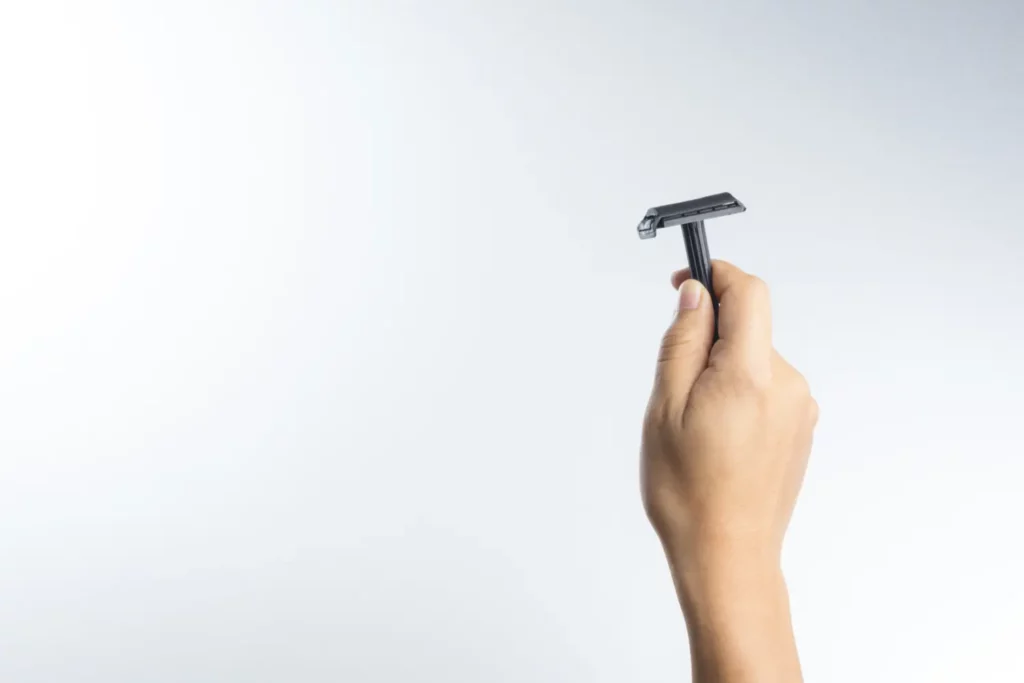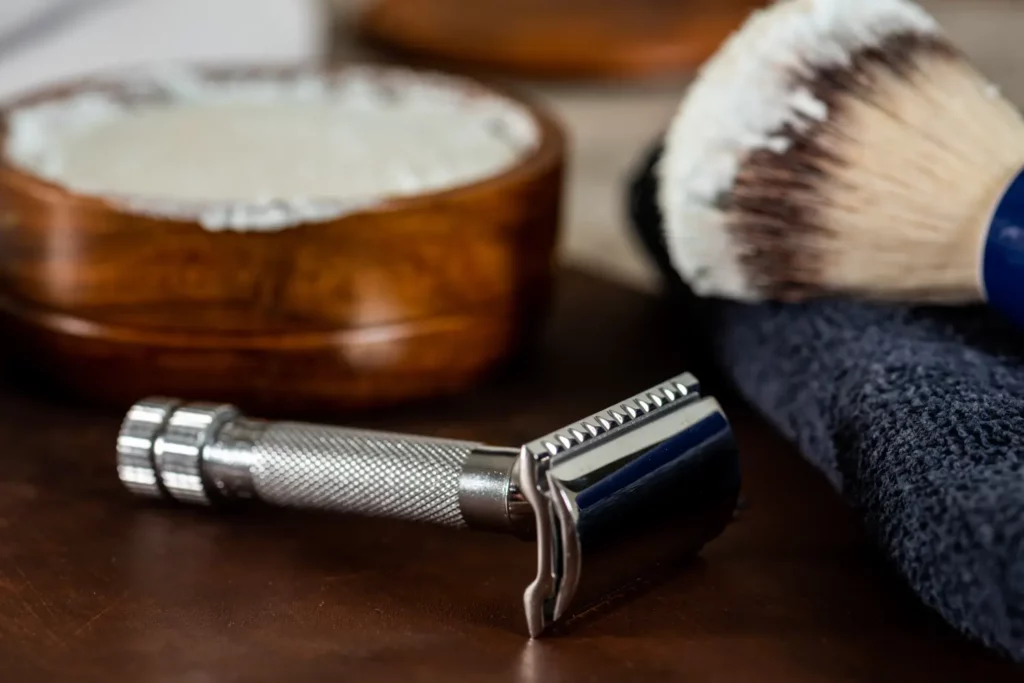For centuries, the pursuit of the perfect shave has led to an array of razor designs and methods. Safety razors, in particular, have gained popularity for providing a closer and more comfortable shaving experience.
However, when compared to modern multi-blade cartridge razors, safety razors won’t achieve nearly as close of a shave in a single pass.
We’ll explain why this is the case along with some additional techniques you can employ to achieve a closer shave with a safety razor.
Key Takeaways
- Safety razors, such as double-edge safety razors, provide a comfortable shaving experience with less irritation, but they may not achieve as close of a shave in a single pass compared to multi-blade cartridge razors.
- These razors consist of a single, double-edged blade and do not experience the hysteresis phenomenon (lift-and-cut) that cartridge razors do.
- Achieving a close shave with a safety razor (DE razor) requires multiple passes (with, across, and against the grain) and proper technique.
- Using quality shaving cream or shaving soap and maintaining the correct blade angle can improve the shaving experience and results.
How Safety Razors Work

Safety razors, as the name suggests, were designed to provide a safer alternative to straight razors used by barbers.
Unlike cartridge razors, which comprise multiple blades attached to a disposable head, safety razors consist of a single, double-edged blade held between a handle and a protective cap, sometimes with a closed comb design. The comb on the safety razor presses against the skin, ensuring a consistent and safe shaving angle. As the blade is exposed only slightly, it provides a level of protection and reduces the risk of cuts and nicks compared to a straight razor.
The single-blade design allows the razor to cut the hair rather low, but some level of grit or stubble will remain.
Did you know: Safety razors were first introduced in the late 19th century and were popularized by King Camp Gillette’s invention of the disposable double-edge blade in 1903.
Do Safety Razors Experience the Hysteresis Phenomenon?
To understand why safety razors can’t cut as close as cartridge razors in a single pass, it’s essential to grasp the concept of the hysteresis phenomenon.
Hysteresis refers to the time it takes for the skin to return to its original position after being stretched or displaced. Modern multi-blade cartridge razors take advantage of this phenomenon by lifting the hair with the first blade and cutting it with the following blades, providing a close shave as the skin relaxes and the hair retracts below the skin’s surface. This article by the New York Times explains the phenomenon in more detail.
This phenomenon is commonly referred to as “lift-and-cut.”
For better or worse, cartridge razors can work either exceptionally well or cause some irritation, depending on the individual’s skin sensitivity and hair growth patterns.
Safety razors, on the other hand, do not experience hysteresis due to their single-blade design. Instead, they glide smoothly along the skin, maintaining the skin’s natural position throughout the shaving process.
Since this shaving tool doesn’t utilize hysteresis as effectively, it may take multiple passes to achieve similar closeness to that of cartridge razors.
Fun fact: Safety razors are also more environmentally friendly compared to cartridge razors, as their blades are typically recyclable and produce less plastic waste, making them a popular choice for eco-conscious individuals.
How to Get a Close Shave with a Safety Razor

Achieving the closest and most comfortable shave with a safety razor may require a learning curve for beginners. Many wet shavers recommend making multiple passes, usually two to three, to progressively reduce facial hair.
This involves shaving in the direction of hair growth (with the grain) in the first pass, followed by passes across and against the grain.
The across and against-the-grain passes do take some practice and caution, as well as short strokes, as the improper technique may lead to nicks or irritation. However, with time, patience, and consistent practice, most users can master the technique and enjoy a close, comfortable shave with minimal irritation. Additionally, using quality shaving cream or soap and maintaining a proper blade angle (generally 30-45 degrees) can significantly improve the shaving experience and results. Wet shaving can also benefit from prep, such as using hot water to open pores before the shave and cold water to close them afterward.
Blade replacement and honing for double-edge razor blades are essential for maintaining a sharp and efficient shaving tool. The butterfly design in some safety razors allows for easier blade swapping, which should be done every 3-7 shaves, depending on the individual’s needs.
Want to learn more? We have several tips and tricks that can help you master your safety razor technique and enhance your overall shaving experience in this guide.
Aside from the obvious benefit of safety razors being far more ecological, safety razors do not cost nearly as much as new razor cartridge refills do. In the past twenty years, I’ve seen the cost of replacement razor cartridges far exceed their worth. I don’t care how close they shave. I stopped falling for the hard sell from the excessively greedy companies that pull the wool over all of us. It’s always some new gimmick they come up with to charge twice as much. And the results never nearly live up to the hype. I don’t care how many rows of blades a cartridge has today; it’s become a ridiculous game of let’s see how easily we can bait the sea of fools.
With men today, it’s as bad as it had been for women in prior decades, and we fall for it like fools. Learn to live with a little stubble and stop feeding the goats your money just because years of social programming on television, movies, books, etc. have convinced you otherwise.
I switched to an electric razor over twenty years ago. It took less than two weeks for my face to adjust to the change. I still have and use the very same Norelco razor I purchased in 2003. I’ve not bought another cartridge since and only replaced the blades once. I cannot even imagine just how much money I’ve not given over to some board of directors and shareholders who couldn’t give a rat’s arse about me, my family, or the state of the world.
I couldn’t tell you if that same razor, if produced today, or any that has been developed since then would last nearly as long as mine has. To be honest, I doubt it, as nothing does anymore.
These past twenty years have seen nothing but an ever-increasing amount of cheaper and cheaper-made products that look great but last a year or so or less. With the sophistication of modern graphic design software and highly sophisticated plastic molding and manufacturing processes, products are now made to look beyond perfection.
Products today are made to appear as if they’re high quality and will last forever, when in fact they are anything but that. All that we’ve been buying, especially over the past decade, is nothing more than imagery and illusion. Oh, the products are pretty, they’re perfect, they wow us and pow us, and they’re nothing but garbage. Nothing lasts because things are purposely not made to last. And for some idiotic reason, most people not only expect this but also accept it. We do so like goofs, giving a shrug and a pass of the credit card, and then off we go!
Just a bunch of automatons, wind us up, and off we go. And when that $100 doodad either doesn’t come close to living up to the promises or falls apart next month, whatever you do, don’t complain, don’t raise a stink, and don’t even let on that you’re dissatisfied. Otherwise, you won’t be seen as a team player or worse, a complainer. Because, after all, ya know crap happens, so man up! Well, screw all of that.
Money doesn’t grow on trees unless it’s a tree you made from lies, and you don’t have a conscience or sense of ethics to care about it.